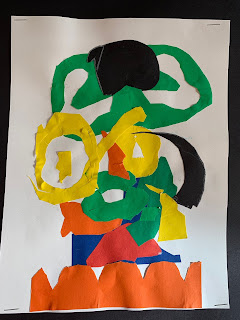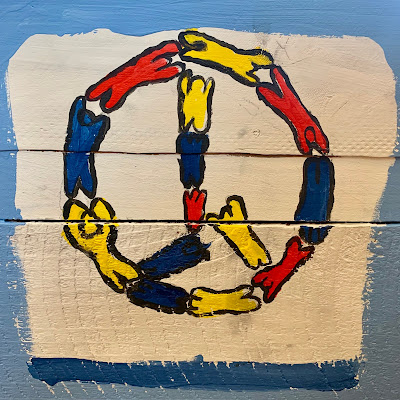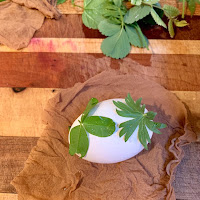Transitional Kindergarten: Snail Line Drawing & RED
TK Students were introduced to the works of Saul Steinberg. Steinber (1914-1999) was a Romanian and American cartoonist and illustrator, best known for his work for The New Yorker. He described himself as a "writer who draws".
Drawing is one of the most important activities for students to practice and it is best to start the practice at a young age. Drawing not only provides the basis for other creative activities- like painting, sculpture and printmaking- but it also provides a direct link with reading, writing and especially mathematics. Drawing is the single most accessible form of art available.
TK students used a felt-tip pen to draw a variety of lines to create an imaginary snail. Students drew a spiral shell into which the snail can withdraw its whole body. Students imagined other creatures living with the snail and drew houses for the "snail's friends" on top and around the spiral shell. The story telling began and an entire snail community was created!
Steinberg often used the color Red to embellish his drawings. Likewise TK students used the powerful hue to add finishing touches to their snail drawing master pieces.
Drawing is one of the most important activities for students to practice and it is best to start the practice at a young age. Drawing not only provides the basis for other creative activities- like painting, sculpture and printmaking- but it also provides a direct link with reading, writing and especially mathematics. Drawing is the single most accessible form of art available.
TK students used a felt-tip pen to draw a variety of lines to create an imaginary snail. Students drew a spiral shell into which the snail can withdraw its whole body. Students imagined other creatures living with the snail and drew houses for the "snail's friends" on top and around the spiral shell. The story telling began and an entire snail community was created!
Steinberg often used the color Red to embellish his drawings. Likewise TK students used the powerful hue to add finishing touches to their snail drawing master pieces.
Kindergarten: Joan Miró Dream Paintings
The unique style of surrealist painter, sculptor and ceramist Joan Miró (1893-1983) is characterized by the use of organic forms and flattened picture planes with sharp black lines.
In a similar fashion, students reviewed lines and geometric shapes and experimented with how these strict boundaries could be counterbalanced with the softness of color and more organic images. In his works, Miró often repeated surrealistic icons, objects and shapes such as: crescent moon, stars, figures with graphic patters, ladders, etc. Students were encouraged to include some of Miró's iconic objects or shapes in their own works, as well as adding imagery from their own dreams.
We think you’ll agree these whimsical dream paintings are a delightful and expressive interpretation of Miró's surreal and ebullient style!
1st GRADE: Henri Matisse Paper Cut-Outs
Henri Matisse (1869-1954) gave up a law career to take up art. While Matisse’s early avant-garde style was quite conventional, his later work became more abstract, characterized by flat shapes and controlled lines, with expression dominant over detail and a fondness for bright colors. Later in life, a serious illness confined Matisse to just his bed and wheelchair. Amazingly, from there he created some of his finest works-- the enormous and breathtaking paper cut-outs.
Students were introduced to the book Henri's Scissors by Jeanette Winter. After reading the book, students experimented "drawing with scissors". Students cut free-form shapes, lines and movements of an imaginary garden out of bright colored collage paper. Students composed and overlapped their cut-out shapes and glued them onto a white background. To complete the paper cut-out collage students designed black silhouette shapes depicting animals, or plants for their imaginary gardens.
2nd GRADE: Trout Collage Inspired by Eric Carle
This project integrates visual arts with science and literature. Second grade students were introduced to the illustrator and author Eric Carle. He is one of the best-known creators of contemporary children’s books. Carle has had an enormous impact on children's literature since the late 1960s. He developed a technique of painting tissue paper in brilliant colors and applying texture with a variety of tools. Carle calls this “painting pretty papers". He uses the papers to create colorful collages to illustrate his stories.
Just like Eric Carle, students painted “pretty papers” and used the collage technique to illustrate rainbow trouts and habitat. This lesson integrates visual arts with the second grade core science unit “The Life Cycle of a Trout”.
3rd GRADE: Basket Weaving
This basket weaving projects connects with the third grade Native American studies. California Natives wove baskets to gather, process, cook and eat acorns. The Acorns were the most important food source from the oak trees, which used to grow all over California. Students were introduced to two basic basket-weaving techniques: Twined and plaited basketry.
Students used flat reed to plate weave the bases of their baskets. Using round reed students practiced to twine weave the wall structure of their baskets. Students will add color and texture accents with bead work. To complete their baskets students will explore different rim finishes.
4th Grade: Visual Arts-Maker Collaboration
During their maker classes 4th grade students worked in teams of 5-6 students to construct and build a planter box out of redwood for the Bacich outdoor science space. The plain sides of the boxes presented themselves as "blank canvas". The perfect opportunity to collaborate and connect this maker project with visual arts!
In January students were introduced to the works of Pop Artist Keith Haring. Haring (1958-1990) was famous in the 1980s for his often large scale art, which was a mixture of graffiti and public art. He used bright colors and simplistic, cartoon like images, expressing and communicating his social, emotional, and political views with his community in New York.
To promote love, kindness, and respect in our community, 4th grade students designed and painted impressive, bright colored, posters in the Haring cartoon style. Students collaborated to reproduce and paint their poster designs onto the sides of the redwood planter boxes. In order to weatherproof the artwork students gesso primed the wood and painted their images with exterior paint. Soon these boxes will beautify the Bacich outdoor science space and other area. A fourth grade legacy for the Bacich campus.

In January students were introduced to the works of Pop Artist Keith Haring. Haring (1958-1990) was famous in the 1980s for his often large scale art, which was a mixture of graffiti and public art. He used bright colors and simplistic, cartoon like images, expressing and communicating his social, emotional, and political views with his community in New York.
To promote love, kindness, and respect in our community, 4th grade students designed and painted impressive, bright colored, posters in the Haring cartoon style. Students collaborated to reproduce and paint their poster designs onto the sides of the redwood planter boxes. In order to weatherproof the artwork students gesso primed the wood and painted their images with exterior paint. Soon these boxes will beautify the Bacich outdoor science space and other area. A fourth grade legacy for the Bacich campus.













































